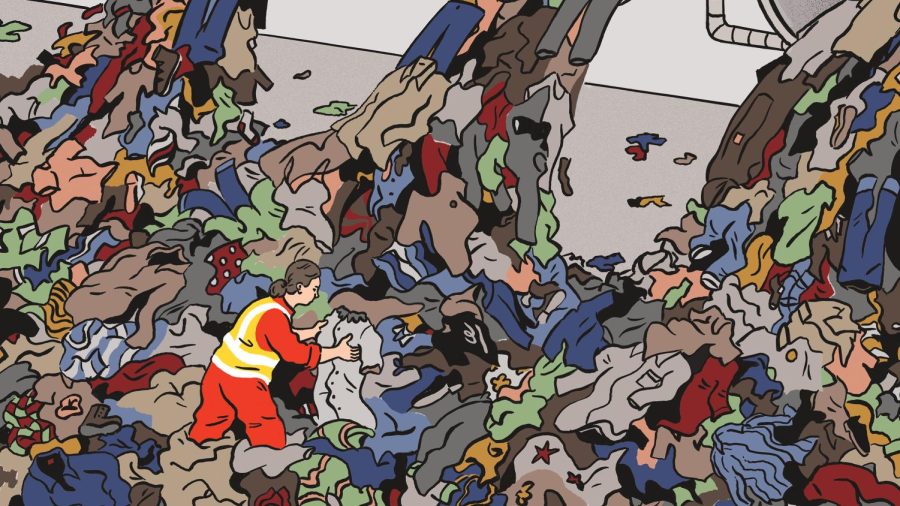The curse of micro-trends
I’m sure we’re all well aware of the impact social media platforms have on us — it’s all anybody talks about. Social media ruins your mental health, Instagram makes you insecure, TikTok is a gateway to comparing yourself to people that you’ll probably never cross paths with a day in your life… we get it.
Everybody talks about how we’re negatively impacted by these social platforms — and don’t get me wrong, it’s a pretty huge issue — but let’s shift gears to a broader, and much bigger picture. Social media doesn’t only harm us directly, but it’s also slowly damaging our environment and the world we live in.
Exposure
Fashion is something we all partake in; walking down the street immediately exposes you to various different styles. Fashion is not only the outfit you chose to put on in order to go about the rest of your day, but it’s also a form of self-expression. An outfit can speak for itself: displaying the emotions, beliefs, and ambitions of its wearer.
Fashion has and continues to evolve as time goes on. Celebrities can heavily influence the style of their fan bases of almost any age, whether that be through billboards, music videos, or posts on social media.
Aseel Ahmed is a high school Junior who loves all forms of fashion, whether that be clothing, accessories, or hairstyles. She states, “What influences me the most are honestly TikToks. If I see a product come up on my ‘For You Page’ multiple times it makes me want to buy it even more.”
High school student Jordan Borwick agrees, saying that what influences her the most is “TikTok and Instagram, and how famous influencers are making a product or clothing item sound so good to buy.”
Junior Fiona Chen adds on, stating: “People I see on social media or at school influence me most to buy new clothing. It gets hard to catch up, especially when you don’t want to feel out of place for wearing something ‘out of style.’”
A common factor to note in the way fashion gets passed down and evolved is the concept of a fashion trend. Trends are a style or way of wearing your clothing that doesn’t last forever, but rather finds a way to evolve into something else or make a comeback in the future. For example, the trend of baggy jeans was a huge style staple in the 90s, and has recently come back as something that you can find in almost any teen’s closet.
Micro-trends
Trends are inevitable in fashion, but are not the real problem here. What many people tend to brush over are micro-trends — yikes!
Micro-trends are short-lived trends, most only lasting about a month or two as opposed to an entire decade or few years. Micro-trends have been infecting the internet, and fueling the build up of environment-damaging fast fashion websites.
Micro-trends are heavily promoted by influencers on social media platforms. Typically, an influencer with a strong following is sponsored by a brand in order to sell their clothing pieces. The process is simple: an influencer gets sent free clothing from any clothing site looking to gain more popularity, and is told to speak highly of it in order to receive benefits, which include a good relationship with the company, promotion of the influencers platform, getting paid, and receiving more freebies.
Influencers tend to put the product under a positive light, even if they think otherwise, solely for the self benefits that come with it. This creates a catalyst of false advertising, making a product sound “too good to be true.” It’s all a trap!
Because the influencer in question is so heavily looked up to, fans immediately rush to purchase similar clothing. This eventually creates a domino effect — creating a fashion “norm” that’s considered popular for a day, and not the next.
Chen makes a good point, stating that “during the pandemic I [she] noticed that micro trends surfaced really often,” and that “staying at home all day and being online made it much easier for people to explore and support fast fashion brands who often promoted a lot of micro-trends to appeal to customers.”
Ahmed speaks of her own experiences during this peak time period of micro-trends, saying: “I have participated in some of those indie girl trends where you buy a lot of fast fashion with prints and like ‘groovy’ designs.”
It all comes from a lust of wanting to have the “coolest look,” look like someone popular, and be somebody that people can look at and admire. For example, a micro-trend of bright, neon colored designs were heavily popular on clothing for a short period of time during quarantine.
Impact: Factory workers
Because micro-trends are so short lived, the mass purchasing of its clothing increases immensely for a period of time, and then dies down quicker than it started.
Not only does this bring companies toward making their employees work overtime, but it makes for horrible working conditions, not paying employees enough, and much more.
An article on the conditions factory workers are faced with as a result of the mass production of clothing from micro-trends states that “Garment workers are often forced to work 14 to 16 hours a day, 7 days a week. During peak season, they may work until 2 or 3 am to meet the fashion brand’s deadline.”
Other than being overworked, “Their basic wages are so low that they cannot refuse overtime – aside from the fact that many would be fired if they refused to work overtime. In some cases, overtime is not even paid at all.” Workers do not get paid enough to provide for themself or their families, which proves to be damaging to mental as well as physical health.
“Employees usually work with no ventilation, breathing in toxic substances, inhaling fiber dust or blasted sand in unsafe buildings. Accidents, fires, injuries, and disease are very frequent occurrences on textile production sites.” In many countries where factory work is at its prime, workers are not protected by laws that ensure their proper treatment and access to healthcare. This is not only a violation of human rights, but something that we all unknowingly promote.
Unfortunately, child labor is one of the overarching factors in the field of textile factory production. “160 million children in the world are forced to work. Because the fashion industry requires low-skilled labour, child labour is particularly common in this industry.” Even if a law is put into place, they are commonly broken, and children are forced into life-risking labor habits and conditions that come with unimaginable consequences.
Impact: The environment
When a trend dies down quickly, the clothes are typically thrown out afterwards. Since these articles of clothing are produced rapidly and out of non-sustainable or environmentally friendly materials, they in turn damage our environment when they are disposed of. Mounds of clothing from micro-trends are thrown out every single year. According to an article on the true impact of fast fashion on our environment, “of the 100 billion garments produced each year, 92 million tonnes end up in landfills.”
And if you thought that was bad, “in America alone, an estimated 11.3 million tons of textile waste – equivalent to 85% of all textiles – end up in landfills on a yearly basis.” To put that into perspective for you, “that’s equivalent to approximately 81.5 pounds (37 kilograms) per person per year and around 2,150 pieces per second countrywide.”
The statistics look detrimental enough on paper, but let’s dive deeper into how intense these numbers are for our environment. That same article states that “nearly 10% of microplastics dispersed in the ocean each year come from textiles,” which is equivalent to the “plastic pollution of more than 50 billion bottles.”
In addition to our animals being continuously faced with life threatening conditions every day, we are also heavily impacted. Production in fast fashion is detrimental to our planet’s health due to the carbon emissions from factories and their use of harmful chemicals to the environment. During quarantine alone, “16 million tonnes of CO2 emissions were created by online returns in the US in 2020 – the equivalent to the emissions of 3.5 million cars on the road for a year.” If we can manage that in a year, imagine the damage that will continue to occur for the next few decades.
The production of clothing has only gotten worse. As opposed to the primary material being cotton, many companies have shifted to using polyester (a type of plastic) instead, as it is more affordable, quick-drying, and wrinkle free: which are all attractive components to a buyer when looking for clothing — thus increasing sales.
Ahmed states that the “whole reason” she was tempted to buy from fast fashion brands was “because they were very cheap and I could buy a lot for less money.”
After educating herself on the harmful effects of fast fashion, she mentions, “I have found myself throwing out clothes that weren’t trending anymore because in the end I realized that I didn’t actually like them for the style, but rather the hype that circled around it. It made me feel kind of bad because I was basically throwing out the money I spent on those items.”
Borwick adds on, making a point that “once people are done with the micro-trends, all the disregarded clothes and fabric that gets thrown out end up in landfills.”
Chen agrees, stating that “fast fashion contributes largely to the waste production of the Earth, which in itself is a big source of pollution and threat to habitats.”
Clothing accounts for a fifth of the 300 million mounds of plastic that ends up in landfills each year. Research on the damaging effects of polyester states that “polyester, a ubiquitous form of plastic that’s derived from oil, has overtaken cotton as the backbone of textile production. Garments made from polyester and other synthetic fibers are a prime source of microplastic pollution, which is especially harmful to marine life.”
Ahmed states that “many of those clothes that are thrown out because a micro trend ended, or just clothing that was overproduced, usually end up in landfills and the material can’t decompose properly. This makes them stay in those landfills for a long time and if they are burned the amount of damage it does to our atmosphere is crazy!”
We always hear about the health of our environment slowly decreasing by the day, but have you ever taken a step back and realized that we are all, in fact, part of the problem?
So, what can we do?
Micro-trends are wasteful and come with many harmful effects, but there’s much we can do to contribute to the betterment of the fact.
Many alternatives such as second hand shopping have increased in popularity, making good use of clothing that would otherwise be thrown away. Thrift shops are being promoted more than ever on social media, and the concept of reselling unwanted clothing on fashion marketplace apps.
The newer generations are starting to popularize these new habits, and surfacing them to the media. So even though micro-trends and fast fashion have been at a peak over the past few years, we are improving.
When asked about the increase in advocating against fast fashion on social media platforms, Ahmed states, “I think the harm of micro-trends are something that people are starting to talk more about on social media, especially with ‘de-influencing.’ I think that if this continues there might be a significant decrease in them that could really help the environment and people.”
Many clothes that were mass produced for micro-trends end up being thrown away, which in itself is a big source of pollution and threat to habitats — but if we all work toward taking sustainable practices with the clothing we wear, advocating for the health of our environment, and understanding its impact, we can bring ourselves one step closer to a superior way of living.







